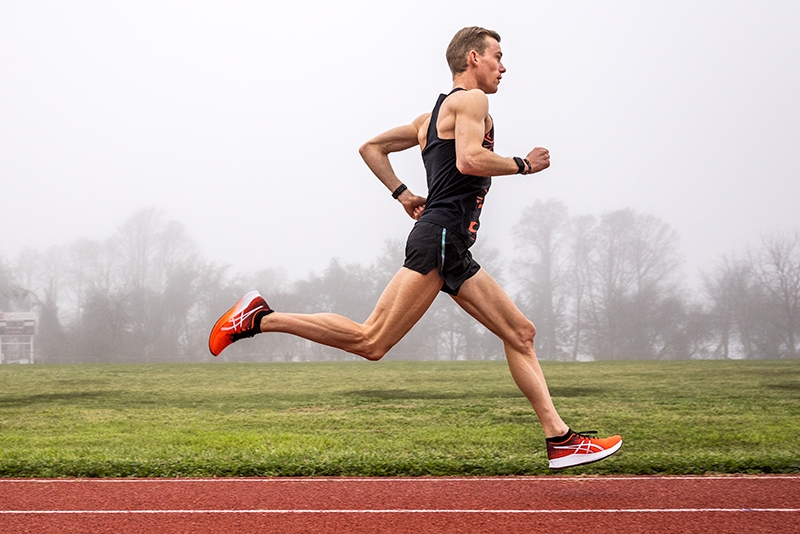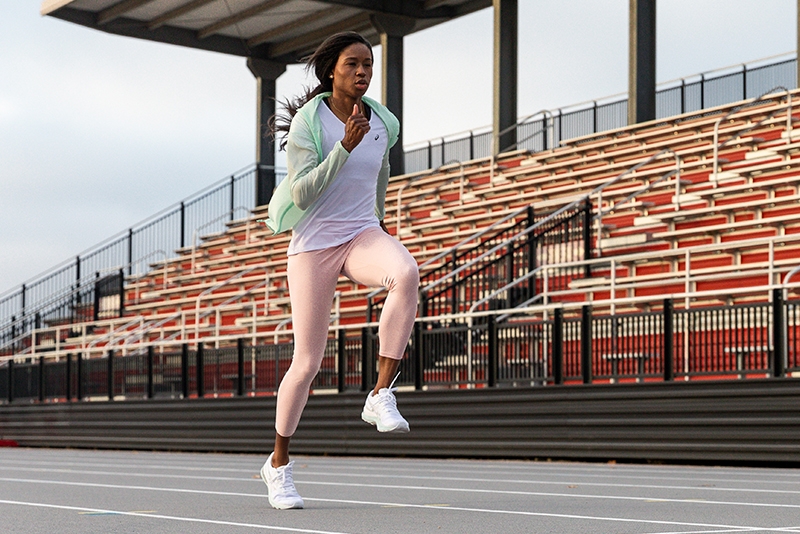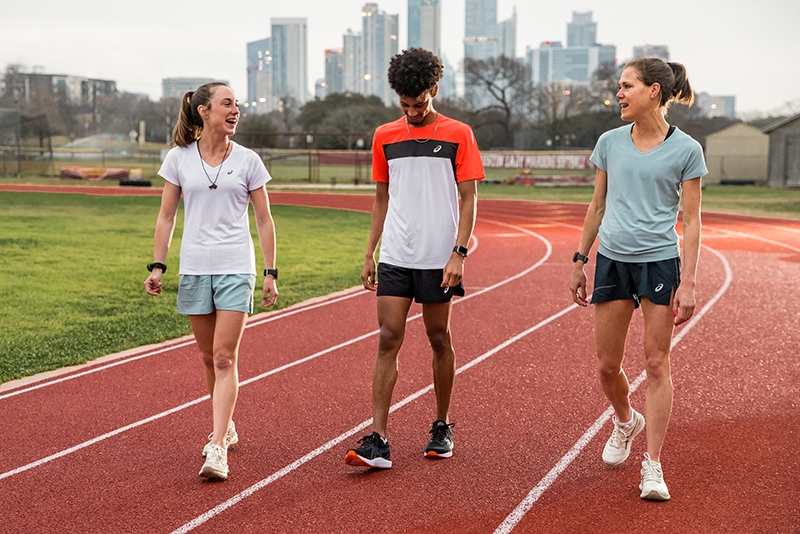Track Workouts for Beginners by Asics
Plus, if you're new to athletic training, track workouts are an awesome way to get into the sport.
By following a few steps and knowing a few techniques for working out on a track, you can have incredible results without having to step foot in a gym. In this article, we will discuss different training sessions to get you on your way towards your first 1K, 5K, or 10K run, or run a personal best in the 100-meter, 200-meter, 400-meter, or 800-meter races.
What Exactly Is a Track Workout?
A track workout, or "track session," is a repetitive, measured exercise on an indoor or outdoor running track. It's an interval session that consists of various lengths, distances, and repetitions of sprints and recovery exercises.
Although they may seem challenging, track workouts will help make you faster and can be a good way to remain injury-free; by following a schedule and avoiding overtraining. Track running can be combined with bodyweight workout activities to build a schedule that meets just about any fitness goals.
Track workouts are also an excellent way to measure progress and improvement towards your athletic goals. They enable you to build towards faster times and track your personal bests for different distances.

Different Training Sessions That Beginners Can Do on the Track
The track can be a great place to train, but when you don’t know anything about training methods and principles, some tips from experienced runners can help. The beginner’s track workout ideas below should give you the necessary knowledge and confidence to jump into some track sessions. Make sure that you:
- Tailor your running distance and pace to what you're trying to achieve
- Work on your running form and technique during changes in pace
- Measure your performance and track progress
- Warm up and cool down thoroughly
Straights and Corners
Straights and corners training is a great way to introduce speed to your training, and it's as easy as it sounds: run the straights faster (based on the distance you are training for) and jog the turns. On a regular track, you might run 100 meters rapidly followed by 100 meters of recuperation. You can do this as many times as you like, but six to eight 100-meter repeats is a strong starter workout.
Ladder
A ladder is a fun way to pace your interval workout. The objective is to start with the shortest interval, then gradually increase the length of each interval (climbing the ladder), before going back down to the shortest interval.
Start with a 100-meter interval, then move on to 200, 300, 400, 300, 200, and then 100. Each interval should be followed by a jog recovery equal to the distance you ran in the previous interval. Thus a 100-meter interval should be followed by a 100-meter jog recovery, and so on. This is a great training method for middle distance and long distance training.
1:1
A 1:1 ratio means that your work and rest intervals are equal. Pick a distance to run (200 meters, 300 meters, and 400 meters work well) and then jog the same distance as your recovery interval.
If you choose 200m as your target distance (one corner and one straight on a 400-meter track), for example, you'll run very hard for 200 meters, then jog for 200 meters, then repeat. This training design is good to practice running consistently at a certain speed and can help you build speed to push for a personal best.
Relays
Who doesn’t love relays? There is something about the thrill of passing the baton that brings out the best in all of us. But first, you need a baton. If you haven’t got a real baton, something like a banana or short stick will suffice. Take turns sprinting intervals. You might begin by running 400 meters (one lap of the track), then pass the baton to your running partner, who will then run 400 meters. Your rest will last as long as it takes them to return the baton to you.
You can do this over any distance, although it is easier to do it over distances that will return you to your starting points, such as 400 meters and 800 meters. This is an excellent approach to add some competition to your training, make it more social, and create a sense of teamwork.
The beauty of being on the track is that you can grab a towel to dry off, grab a water bottle from your bag, or move to a quiet spot and do some strength and conditioning work too.
Strength and Conditioning Workout Exercises for the Track
Strength and conditioning exercises are particularly important for sprints and shorter running distances but are useful for all distances. Here are some exercises for you to do on the running track.
Push-ups: These are one of the best strength-building exercises. Starting from a position on your hands and toes (the plank position), lower yourself down slowly until your chest touches the ground and then push back up with your arms, returning to the original plank position. If you want more of a challenge, try doing them with your hands on two weight plates.
Walking lunges: This is a great exercise for the quads and glutes. Start by standing tall with your feet together, then step out with one leg and lower yourself down until your leg forms a 90-degree angle with the track, then step forward back to the starting position. Repeat with the other leg.
Plank: This is a core-strengthening exercise that involves lying face down on the floor, supporting your body weight on your forearms which are placed directly below your shoulders, and then raising yourself up onto your toes and holding for the count of 20, 30, or 60, for example. What's great about this exercise is that they can be performed anywhere, so no excuses not to do them.
Burpees: This exercise is performed by starting in a standing position, squatting down and placing both hands on the floor, then kicking out your legs so you end up in a push-up position before returning your feet to below you and standing up straight.
Standing long jump: Stand with your feet placed shoulder-width apart. Take a small hop forward, then jump as far as you can. To increase difficulty, add weights in your hands.
Side plank: Lie on your side, propping yourself up with one elbow bent at a right angle and the other stretched upwards fully. Hold this position for one minute, or as long as you can, then repeat the other way around. Make it more challenging by raising your top leg towards the sky slowly.

Indoor Versus Outdoor Track Workouts
Indoor track sessions differ very little from outdoor track workouts. The main difference is the track and the season.
Track Size and Design
The indoor track uses a 200-meter long (or sometimes longer) track surface with six lanes, while the outdoor track uses a 400-meter (or sometimes longer) track with eight lanes. Indoor tracks must be totally enclosed, according to USA Track & Field standards.
Many indoor tracks are banked at a 10- to 15-degree angle to help combat centrifugal force when negotiating turns, which is not a feature of an outdoor tracks' design. Indoor tracks necessitate additional curves and corners, which can slow runners down. The current men's outdoor record in the 400m is 43.03; the indoor record is 44.52. The women's outdoor record in the 400m is 47.60; the indoor record is 49.59. This shows the effect of the additional corners on the smaller indoor track.
Indoor and Outdoor Seasons
The indoor track season in the United States is from December to March. Indoor track work is often used in preparation for the outdoor season, which runs from March to July. You’ll find a bustling indoor track community during the indoor season. Indoor sessions can be a great time to start running, build a social network for running, or become part of a running community.

Get Started on Your Track Workouts With Confidence Today
The quality of a workout is all about the benefits you achieve, whether that means weight loss, improved muscle tone, or just the general feeling of being fit and healthy. Track workouts are a versatile way to get into running if you're relatively new to the sport. You can get a little bit of everything in a track workout, including endurance, strength, speed work, and tempo runs. Track workouts are usually pretty straightforward, which makes them a good place to start as a beginner runner.

